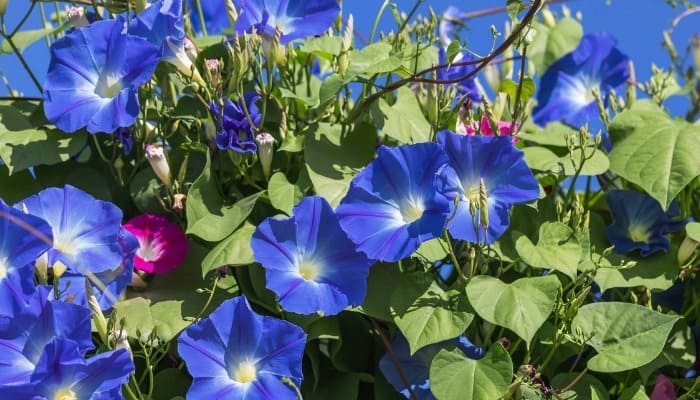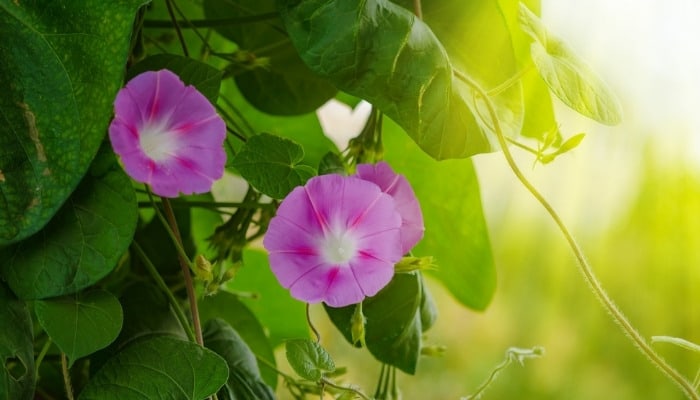The charming heart-shaped leaves of this vibrant climbing plant are a delightful sight, making it disheartening to witness their emerald-green color fade and transform into an unattractive yellow. What could possibly be causing this change?
Why are my morning glory leaves turning yellow? Morning glory leaves turn yellow when conditions don’t sufficiently mimic its native sunny woodland habitat. It needs 6-8 hours full sunlight, moist yet well-draining soil, and balanced watering to thrive. Anything less weakens the foliage, exposing it to disease and causing discoloration.
This normally resilient plant will start to display all kinds of leaf issues when grown in the wrong environment, so to ensure the health of your morning glory plant, let’s troubleshoot the common causes of yellowing.
We’ll also take a look at other leaf issues from rust to wilting, so let’s jump right in.
7 Reasons for Yellow Leaves (and Solutions)
There are many causes of yellowing leaves in morning glories, everything from unbalanced watering to creepy crawlies. Here are the common culprits and their fixes.
Lighting Issues
Morning glory performs best in full sun, so shady garden spots will stress the plant out, leading it to produce less chlorophyll as it adapts.
Solution
Transplant/move your morning glory to an area that receives at least 6 hours of direct sunlight, and prune the worst affected leaves with sterile pruning shears.
Consider also trimming back plants/trees that could be shading it.
Overwatering
An overly moist area weakens leaves and suffocates the roots, providing a breeding ground for fungal organisms and root rot.
Solution
Prune excessively yellow leaves and ensure your morning glory is planted in loose, well-draining soil (like a peat moss-based medium).
Water enough to moisten the soil, but don’t let water stand around the roots.
Underwatering
Morning glories needs regular water to thrive – even a week-long drought will see young, developing morning glories suffer and begin yellowing.
Solution
Provide an inch of water per week in the absence of rainfall, and place a layer of mulch around the roots to encourage moisture retention.
Disease
Excessively wet conditions and poor air circulation can soon promote leaf viruses, causing white powdery pustules on the leaf undersides and yellow/orange discoloration.
Solution
Prune infected leaves, and refrain from overhead watering. Also, prune bushy areas regularly to promote better airflow.
Water in the mornings as opposed to afternoons so that splashed leaves can dry and to avoid rapid moisture evaporation.
Pests
Leaf miners and cotton aphids attack the leaves by boring holes and sucking the leaf sap, draining them of energy and color.
Solution
Dislodge aphid masses (tiny green oval bugs) with a spray of water and apply neem oil pesticide (I’ve found that this organic neem oil works really well) to affected leaves.
Deter infestations by keeping your plant well watered.
Too Much Fertilizer
Overdoing the fertilizer deposits salt in the soil that accumulates and prevents the proper uptake of water, resulting in discolored foliage.
Solution
Feed your morning glory with a low-nitrogen fertilizer (Espoma has a great 5-10-5 fertilizer) every 4-5 weeks during their growing period.
Cease fertilizing altogether once they are mature (within 2-3 months or longer when grown from seed).
Cool Temperatures
In frost-prone areas, cooler nighttime temperatures will cause some leaf yellowing, signaling the end of your morning glory’s lifespan.
Solution
If your morning glories are growing in containers, bring them indoors before the first local frost date.
In tropical climates, morning glory is grown as a perennial but is an annual everywhere else and will die in winter.
Other Morning Glory Leaf Problems

Leaf Rust
Overly wet conditions can cause tan/rust or black spots to appear on the leaves, often with yellow “halo” rings forming around them.
These are caused by spores, which are transmitted from infected plants or tools, that lie in wait until conditions are ripe.
Solution
Prevent rust spots from spreading into large patches by removing infected leaves the minute rust appears, and water at soil level rather than overhead.
Always sterilize your tools before/after with rubbing alcohol too.
The Planet Natural Resource Center also recommends raking the soil clear of any fallen debris to prevent splashback onto healthy upper foliage and applying copper fungicide spray (find it here) at the first sign of trouble.
Browning Leaves
Leaves that appear bleached/brown or begin displaying crispy, brown edges are usually suffering from sun scald, which causes chlorophyll to break down.
Solution
Move your morning glory to a spot where it can get some afternoon shade or place a shade canopy/trellis overhead.
Maintain a balanced watering regimen and ensure the soil remains lightly moist as insufficient moisture can also lead to browning foliage.
Wilting Leaves
Leaf wilting is typically caused by unbalanced watering but can also be caused by insect attacks – specifically leafcutters (small green caterpillars).
These critters feed on the leaf stems at night, partially severing the stalks and inhibiting water uptake.
Solution
You can pick leafcutters off the leaves by hand. Otherwise, grower Nicole Nikki over at Have the Best Garden recommends making this quick caterpillar-busting spray:
“Mix ½ a teaspoon of Bacillus thuringiensis (a natural soil-dwelling bacterium that produces a bug-killing toxin) in 1 gallon of water and mix well before spraying the solution directly onto the leaves.”
Related Questions:
Are Morning Glory Leaves Edible?
Morning glories are not edible. Those claiming morning glory (Ipomoea purpurea) is edible often have this American vine plant confused with Asian water spinach bearing the same nickname.
I. purpurea leaves contain a toxic sap rich in alkaloids that can cause dizziness, tremors, and possible death in humans and pets.
Why Are My Morning Glory Leaves Curling?
Morning glories are susceptible to potato leaf curl virus that is often transmitted by aphids infected with the blight.
Morning glory vines growing near invasive Alianthus trees can also curl due to the tree’s toxic sap.
Apply insecticide around mid-season or grow morning glory in containers to avoid neighboring plant damage.
Conclusion
There are many reasons behind morning glory leaves yellowing.
Fortunately many are easily remedied by pruning the worst affected leaves and making a few environmental changes, like sticking to the proper water schedule or providing the right amount of light/shade.
Your morning glory leaves can suffer other issues too, like browning and wilting, but identifying these changes early can help you take effective action against the pests or fungal infections responsible.

